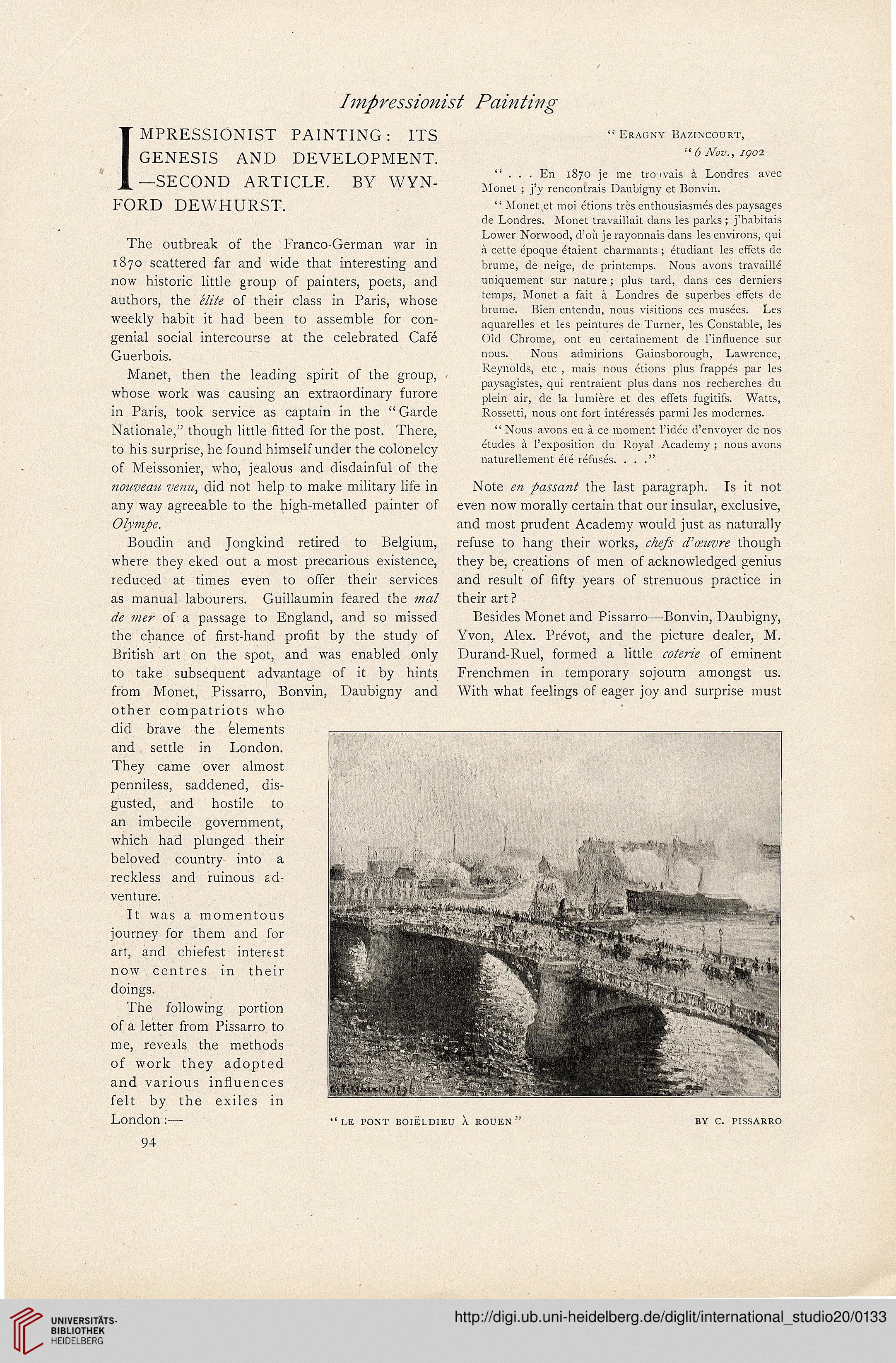TMPRESSIONIST PAINTING: ITS
] GENESIS AND DEVELOPMENT.
!—SECOND ARTICLE. BY WYN-
FORD DEWHURST.
The outbreak of the Franco-German war in
1870 scattered far and wide that interesting and
now historic little group of painters, poets, and
authors, the ////? of their class in Paris, whose
weekly habit it had been to assemble for con-
genial social intercourse at the celebrated Cafe
Guerbois.
Manet, then the leading spirit of the group,
whose work was causing an extraordinary furore
in Paris, took service as captain in the " Garde
Rationale," though little fitted for the post. There,
to his surprise, he found himself under the colonelcy
of Meissonier, who, jealous and disdainful of the
ZWM, did not help to make military life in
any way agreeable to the high-metalled painter of
Boudin and Jongkind retired to Belgium,
where they eked out a most precarious existence,
reduced at times even to offer their services
as manual labourers. Guillaumin feared the 7/M/
</<? 77^7- of a passage to England, and so missed
the chance of first-hand profit by the study of
British art on the spot, and was enabled only
to take subsequent advantage of it by hints
from Monet, Pissarro, Bonvin, Daubigny and
other compatriots who
did brave the elements
and settle in London.
They came over almost
penniless, saddened, dis-
gusted, and hostile to
an imbecile government,
which had plunged their
beloved country into a
reckless and ruinous ad-
venture.
It was a momentous
journey for them and for
art, and chiefest interest
now centres in their
doings.
The following portion
of a letter from Pissarro to
me, reverls the methods
of work they adopted
and various influences
felt by the exiles in
London:—
" ERAGNY BAZtXCOURT,
"... En 1S70 je me troivais a Londres avec
Monet ; j'y rencontrais Daubigny et Bonvin.
" Monet ,et moi etions tres enthousiasmes des paysages
de Londres. Monet travaiilait dans les parks ; j'habitais
Lower Norwood, d'ott je rayonnais dans fes environs, qui
a cette epoque etaient charmants ; etudiant les effets de
brume, de neige, de printemps. Nous avons travaille
uniquement sur nature; ptus tard, dans ees derniers
temps, Monet a fait a Londres de superbes effets de
brume. Bien entendu, nous visitions ces musees. Les
aquaretles et les peintures de Turner, les Constable, les
Okl Chrome, ont eu certainement de l'inftuence sur
nous. Nous admirions Gainsborough, Lawrence,
Reynolds, etc , mais nous etions plus frappes par les
paysagistes, qui rentraient plus dans nos recherches du
plein air, de la lumiere et des effets fugitifs. Watts,
Rossetti, nous ont fort interesses parmi ies modernes.
" Nous avons eu a ce moment l'idee d'envoyer de nos
etudes a l'exposition du Royal Academy ; nous avons
naturellement ete refuses. ..."
Note <?73 the last paragraph. Is it not
even now morally certain that our insular, exclusive,
and most prudent Academy would just as naturally
refuse to hang their works, though
they be, creations of men of acknowledged genius
and result of fifty years of strenuous practice in
their art ?
Besides Monet and Pissarro—Bonvin, Daubigny,
Yvon, Alex. Prevot, and the picture dealer, M.
Durand-Ruel, formed a little of eminent
Frenchmen in temporary sojourn amongst us.
With what feelings of eager joy and surprise must
94




